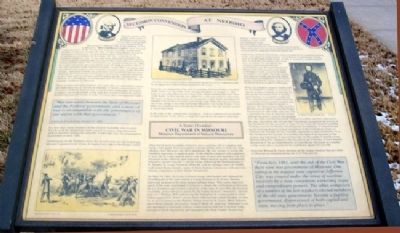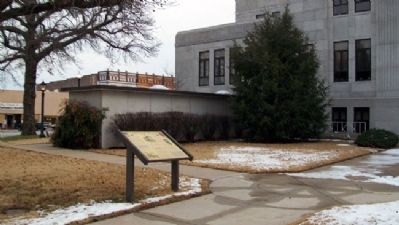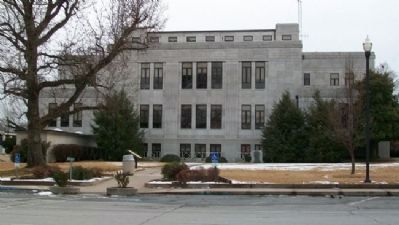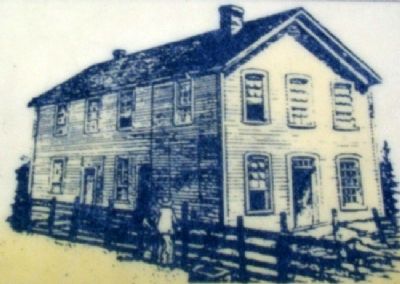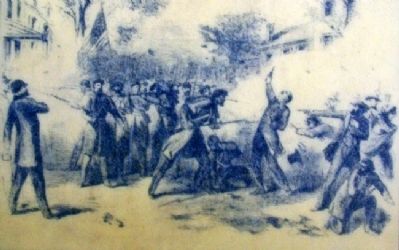Neosho in Newton County, Missouri — The American Midwest (Upper Plains)
Secession Convention at Neosho
A State Divided: Civil War in Missouri
Directly in front of this marker, at the corner of Washington and Spring Streets, there stood in 1861 a two-story frame building that served as a Masonic Hall. In this building, known as Missouri's "first Confederate Capitol," there occurred a special session of the Twenty-first General Assembly, lasting from October 21 through October 28, 1861. At that extraordinary session an Ordinance of Secession was passed that, upon recognition by the Confederate government on November 28, 1861, made Missouri the twelfth Confederate state. At the same time, Missouri also had in place a provisional government that was loyal to the Union and was backed by federal military might. This government was created on July 23-31, 1861, by a state convention that met and declared all of the executive offices of the state and seats of the General Assembly vacant. This convention then proceeded to put in place a provisional government to carry on the functions of state. Hamilton Gamble was selected to act as a provisional governor. Although the Unionist provisional government was originally intended to serve only until an election could be held to fill the vacated offices, this election, as it turned out, was postponed until November, 1864, due to wartime conditions in Missouri.
Those senators and representatives who were able to evade federal capture and make their way to Neosho by October 21 heard a proclamation by Governor Claiborne Jackson that accused federal authorities of waging a ruthless war on the people of the state that in turn justified the people abandoning peaceful means in order to secure their constitutional rights.
"War now exists between the State of Missouri and the Federal government, and a state of war is incompatible with the continuance of our union with that government."
Claiborne Fox Jackson, October 21, 1861
In a few days, those members of the General Assembly who reached Neosho took the preliminary steps toward secession, steps Governor Jackson had been hoping the assembly would take since his inauguration as governor in early 1861.
Unfortunately for the Southern cause, this gesture came too late to dislodge Missouri's position in the Union. At nearly every step on the bumpy road to secession, Jackson and his fellow disunionists found themselves outmaneuvered by an aggressive Union faction centered in St. Louis.
From the very beginning of his term as governor, Jackson felt that a breakup of the Union was inevitable. In his inaugural address on January 3, 1861, Jackson stated that Missouri, as a slave state, should stand by her sister states of the South. At that time he also called for a state convention to determine Missouri's relation to the
Union. In issuing this call he badly misjudged the strength of disunionist sentiment in the border state. When the state convention met in the spring, it not only reaffirmed Missouri's ties to the Union, it also took a firm stand against coercing the Southern states that had already seceded to rejoin the Union.
In the wake of the "submission convention," Jackson experienced yet another disappointment in his efforts to lead Missouri down the path to secession when the General Assembly refused to pass a military bill to organize and equip a state guard. Jackson required a strong military force to back any steps taken to carry Missouri into the Confederacy. He also needed to secure the munitions necessary to equip an army. To this end he conspired with supporters to seize the St. Louis arsenal and its vast store of arms and munitions but was frustrated in this effort by alert Unionists. When Jackson angrily and defiantly refused to answer Lincoln's call for troops following the bombardment of Ft. Sumter, St. Louis Unionists filled the void by raising a force of 10,000 well-armed Home Guards, many of them German-Americans with previous military experience in their former homelands.
On May 10, 1861, St. Louis Unionist troops surrounded and captured the First Brigade of the state militia at Camp Jackson in St. Louis, thereby depriving Jackson of his best-trained military
force. This action shocked much of the state and helped to bring to a climax the confrontation between the pro-Southern and Unionist elements of the state. In mid-May the General Assembly, at last driven to action by the Camp Jackson "massacre," passed Jackson's Military Bill authorizing the formation of a state guard to resist federal aggression. A brief uneasy truce followed that ended abruptly on June 11, in an encounter at the Planters House hotel in St. Louis. Here Jackson met with his federal adversaries, Frank P. Blair, Jr., and Gen. Nathaniel Lyon, and attempted to forestall a direct confrontation with the Unionists long enough to finish organizing and equipping the State Guard. Suspecting Jackson's motives, Lyon would have none of this and announced to the governor that a state of war now existed between the federal and state governments. Three days later Lyon moved on Jefferson City and drove Jackson and his supporters from the capital city.
Following a skirmish at Boonville, Jackson headed for the southwest section of the state, where he made contact with Arkansas Confederates. On the way, his 6,000 State Guard troops, on July 5, scattered a smaller federal force at the Battle of Carthage. One month later, on August 10, assisted by the Arkansas State Guardsmen and Confederates, the Missouri State Guard defeated the federal army at the Battle of Wilson's Creek;
Lyon fell mortally wounded in the battle. The State Guard then marched north and won the Battle of Lexington on September 18-20, before being compelled by a large federal army to retreat back to southwest Missouri.
While at Lexington, Jackson issued a call for the General Assembly to convene in special session at Neosho on October 21. During the first week of the Assembly little business was actually conducted. Those members present found it necessary to await the arrival of more senators and representatives in order to secure a quorum. No official roster of the members present was recorded, nor did the Senate Journal list roll calls of the votes cast. This is probably because no quorum existed, although the point is moot on two grounds; first, the entire membership of the General Assembly had been deposed by the state convention and, second, the Confederacy recognized the actions of the Neosho/Cassville assembly as legal. In any event, the General Assembly went into session on October 28 and passed an ordinance of secession and an act ratifying the provisional constitution of the Confederate States of America. On October 29, the Assembly adjourned to meet on October 31 at the courthouse in Cassville. It was there that most of the business of the session was transacted. It was in Cassville, on November 3, that Governor Jackson affixed his signature to the acts drawn up
in Neosho. A more detailed discussion of the accomplishments at Cassville are discussed on a marker in this series that is located on the courthouse square in Cassville.
Historian William R. Geise summed up the unique situation that prevailed in Missouri government during the Civil War period:
"From July, 1861, until the end of the Civil War, there were two governments of Missouri. One, sitting in the regular state capitol at Jefferson City, was created under the stress of wartime necessity by a state convention, exercising vague and extraordinary powers. The other, composed of a number of the last regularly elected members of the old state government, became a fugitive government, dispossessed of both capital and state, moving from place to place."
Topics and series. This historical marker is listed in these topic lists: Government & Politics • War, US Civil. In addition, it is included in the Missouri - A State Divided: The Civil War in Missouri series list. A significant historical date for this entry is January 3, 1861.
Location. 36° 52.163′ N, 94° 22.069′ W. Marker is in Neosho, Missouri, in Newton County. Marker is on Spring Street near Wood Street, on the left when traveling west. Marker is on the north grounds of the county courthouse. Touch for map. Marker is at or near this postal address: 101 South Wood Street, Neosho MO 64850, United States of America. Touch for directions.
Other nearby markers. At least 8 other markers are within walking distance of this marker. Confederate Capitol of Missouri (a few steps from this marker); 20th Century Wars Memorial (within shouting distance of this marker); Newton County World War II Memorial (within shouting distance of this marker); Haas Building (within shouting distance of this marker); Heaton Building (about 400 feet away, measured in a direct line); Downtown Neosho Historic District (about 500 feet away); Haas Warehouse Building (about 600 feet away); Rocketdyne (approx. 0.2 miles away). Touch for a list and map of all markers in Neosho.
Also see . . .
1. Missouri's Provisional Union Government. Community and Conflict website entry (Submitted on August 7, 2011, by William Fischer, Jr. of Scranton, Pennsylvania.)
2. The Twelfth Confederate State. Community and Conflict website entry (Submitted on August 7, 2011, by William Fischer, Jr. of Scranton, Pennsylvania.)
3. Political Policy in Missouri, 1861. Community and Conflict website entry (Submitted on August 7, 2011, by William Fischer, Jr. of Scranton, Pennsylvania.)
4. Confederate State Ordinances of Secession. Civil War causes website entry (Submitted on August 7, 2011, by William Fischer, Jr. of Scranton, Pennsylvania.)
Credits. This page was last revised on March 18, 2022. It was originally submitted on August 7, 2011, by William Fischer, Jr. of Scranton, Pennsylvania. This page has been viewed 1,255 times since then and 52 times this year. Photos: 1, 2, 3, 4, 5. submitted on August 7, 2011, by William Fischer, Jr. of Scranton, Pennsylvania.
